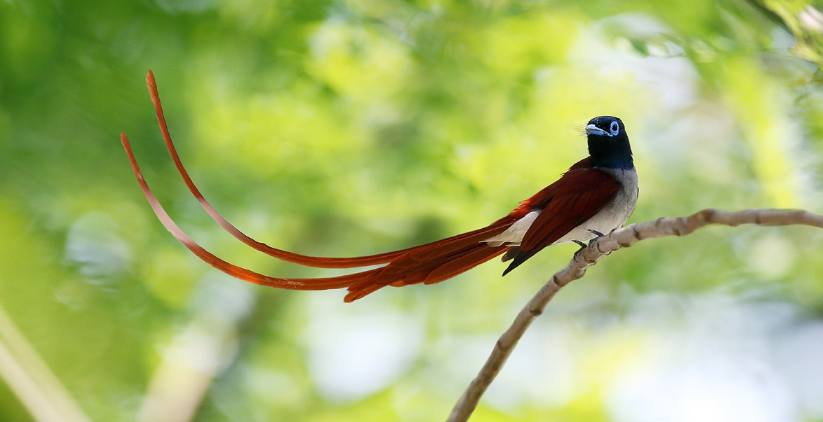Early one morning some birdwatchers ailed me to help them photograph le elusive paradise flycatcher. We gathered our camera equipment, and headed north for Yang County along National Highway No.108. Along the way, we passed through Longting, an ancient town famous for the tomb of Cai Lun, the inventor of papermaking. Eventually, we drove into a hilly region and went down an old country road. Several cottages sheltered by dense woods lie scattered about near the end of the road. When we disembarked with all our camera gear, an elderly woman emerged from her hut, knowing instantly that we had come to photograph the “The Forest Fairy”. She told us to continue along to the next cottage, where we could find many paradise flycatchers in the trees and flying about the yards. A short walk later, we spotted a white paradise flycatcher.
The paradise flycatcher (Terpsiphone paradise) is known by many names in China, including: Baidaizi, Changweibalian and Shoudai. But it is commonly called the “Forest Fairy” for its beautiful feathers and elegant manner of flight. The males have white elongated tail feathers, whereas the females red and black plumage with short tail feathers.
The paradise flycatcher’s distribution and habitat covers the wooded hilly areas around Qin Mountain and Hanzhong Basin, though in recent years data shows that it is rarely ever seen. Yang County is also a world-renowned location for viewing crested ibis. The best time of the year to see paradise flycatchers is during the breeding season around the middle of May, when they have migrated from the south to Yang County.
Paradise flycatchers nest in tree branches. Some of their preferred nesting sites include trees like the Chinese mahogany, persimmon trees, and paper mulberry. They build their nests at a height between 1.5m to 15m, and often near farmhouses to help keep predators away.
We set our cameras under the cottage’s roof so as not to disturb the white paradise flycatcher. It flitted back and forth among the trees, chirping and twittering. The bird’s long tail seemed like a white ribbon flying in the air. The birdwatchers were amazed by its graceful aerobatics: the way “Forest Fairy” swooped down from the tree canopy to prey on flying insects. Then another one was heard chirping in the trees. It was a brown female paradise flycatcher, watching over a nest full of chicks peeping out with tiny heads and opening their small beaks. The monogamous pair took turns hunting insects to feed their chicks.
Meanwhile, we stayed busy photographing every perfect moment after another, cheering each time one of the paradise flycatchers found an insect and delivered it to the chicks.



























